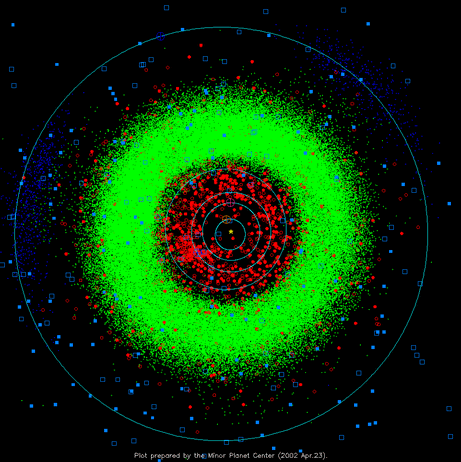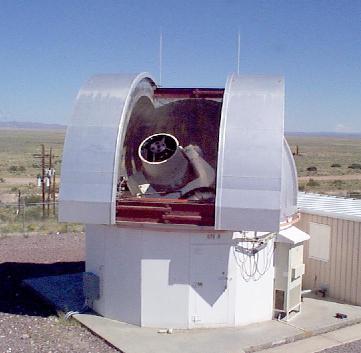
Asteroids
and comets on orbits with perihelion
distance q<1.3 AU
and aphelion
distance Q>0.983 AU are usually called Near Earth Objects
(NEOs).
 |
VIEW OF THE INNER SOLAR SYSTEM: The yellow dot at the center of the image represents the Sun. The light blue circles show the orbits of Mercury, Venus, Earth, Mars and Jupiter (from smallest to biggest). The locations of the main belt asteroids are indicated by green dots. NEOs are shown by red circles. The two "clouds" of deep blue objects close to Jupiter's orbit are the Trojan asteroids. Periodic comets are shown as filled light-blue squares. Other comets are shown as unfilled light-blue squares. From the Minor Planet Center website. |
It is now recognized that the NEOs constitute a potential danger for human civilization. The blast caused by the impact of a kilometre-sized NEO on Earth produces the energy equivalent of 50,000 Megatons of TNT. It is believed that these types of events could cause regional-to-global ecological and economical catastrophes.
The extinction of dinosaurs 65 million years ago is believed to have been caused by the impact of an NEO approximately 10 kilometres in diameter. Evidence suggests that the impact occurred in the vicinity of Mexico's Yucatan peninsula.
Currently, about 1500 NEOs of all sizes are known,
their number increasing daily thanks to the work of several dedicated ground-based
surveys such as LINEAR,
SPACEWATCH,
CSS,
NEAT
and LONEOS.
| The Lincoln
Near Earth Asteroid Research (LINEAR) project is currently the
most effective survey for the discovery of new NEOs.
The LINEAR program uses a pair of GEODSS telescopes at Lincoln Laboratory's Experimental Test Site (ETS) on the White Sands Missile Range in Socorro, NM. The telescopes are equipped with Lincoln Laboratory developed CCD electro-optical detectors and observations are processed on site. To date, LINEAR has discovered 951 new NEOs and 82 comets. |
 |
The goal of this project is to answer to
the following fundamental questions: